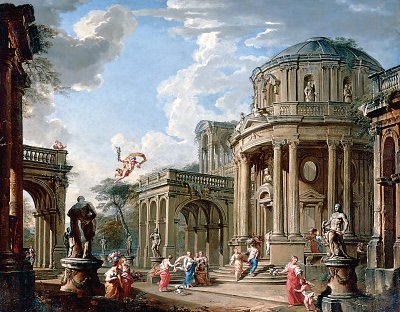 |
|
Hermes appears to Calypso
Giovanni Paolo Panini, Italian 1691-1765
SN 171, Oil on Canvas
by Robert Anderson.
Artist:
Panini is best known for his paintings of Rome's antiquities. His vedute ( accurate
landscape paintings) focused on Rome's Classical past. Ceremonies and festivals are often
featured in his paintings which thus relate a documentation of contemporary topography,
lifestyle and customs. By 1711 he had become the pre-eminent painter of real and imaginary
views of the city. He often worked in the so-called "gallery' genre : paintings of
hugh interiors stacked with the most famous views of Rome and constituing a kind of
imaginary museum. |
The paintings from his earliest years were of a relatively simple mold but
over the next several years his compositions became increasingly independent and
elaborate. After 1720, Panini concentrated on highly religious and legendary subjects in
vast classical architectural settings.He was documented as an architect as well as an
artist and had served on a panel of judges for architectural competitions.
Panini was also had an enviable reputation as a decorator of interiors,
painting frescos for many villas in Rome. As his reputation grew he was nominated to the
Accademia di Saint Luke where he taught perspective drawing and later served as principal.
Subject:
This subject comes from Homer's Odyssey ( Chapter 5 Lines 50 - 60). It relates the story
of the freeing of Odysseus from the island of Calypso, a sea-nymph. Calypso had received
Odysseus hospitably, entertained him magnificently, became enamored of him, and wished to
retain him forever, confering on him immortality. Odysseus persisted in his desire to
return to his country, his wife and son. Calypso at last received the command of Zeus to
dismiss him. Hermes brought the message to her and found her in her grotto.
She then supplied Odysseus with the means of constructing a raft,
provisioned it well for him and gave him a favoring gale.He sped on his course
prosperously for many days.
Painting:
This painting shows Hermes appearing to Calypso to transmit a command from Zeus. The scene
is set in the open court of a magnificent palace.
Painted early in his career, this painting shows a level of
experimentation for the young artist and a level of inspiration not often found in his
later works. The painting features illusionistic architecture in the monumental palace of
Calypso, which provides a grandiose architectural background for the picture. The painting
is also notable for its fresh color and liquid brushwork, which are fully rococo in
flavor.
Historical Context:
Rococo art was a lighter and more artificial version of the baroque and was associated
with the reign of Louis XV in France. More identified in the decorative arts than in
painting or architercture it is typified by asymmetry and the use of florid S-curves and
C-scrolls. It's subject matter was usually that of transformation and therefore a suitable
style particularly for the Circe entertaining Odysseus painting.
Paintings such as these with monumental and classical architecture
settings were heavily in demand by contemporary tourists visiting Rome as they included
views of actual or imagined monuments of ancient Rome.
|
